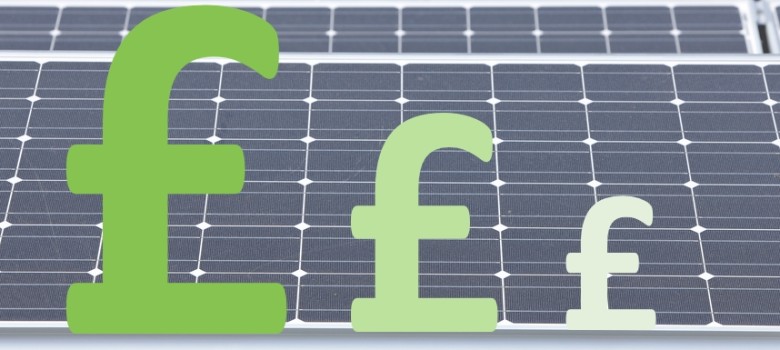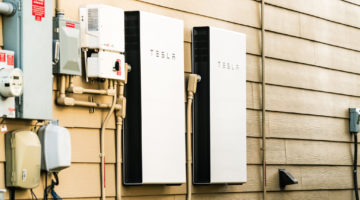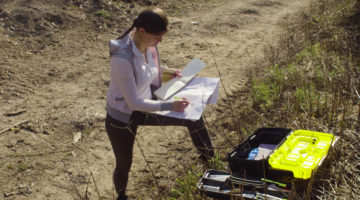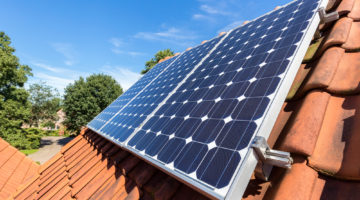
How much do solar panels cost?
Solar PV panels have reduced in price by approximately 40% as a result of falling manufacturing costs and increased competition in the market. This means you can now get a decent sized solar PV system installed on your roof for between £4,000 and £6,000.
We would always recommend trying to maximise the number of solar panels that you go for – but this is often limited by the size of the roof space.
A 250w solar panel will typically cost between £300 and £500 and each panel is approximately 1.7m2. Therefore for a 3.5kW system, you are looking at a price of between £4,200 and £7,000, and this would take up approximately 23.8m2.
For a smaller 2.0kW system, you are looking at paying between £2,400 and £4,000 and this size system would take up approximately 13.6m2.
Obviously, the more solar panels you have on the roof, the more electricity you can produce. This therefore means you need to buy less electricity from the grid (as you can use the electricity you produce).
You can also get payment from your energy supplier, provided they are signed up to the Smart Export Guarantee (SEG).
The SEG is a legal obligation for any electricity supplier that supplies at least 150,000 customers to offer an export tariff to those with solar panels for each kWh produced.
The actual export tariffs these energy companies offer can be flat, variable or smart rate (adjusting based on wholesale prices), however the tariff must always be greater than zero (even when wholesale prices of electricity are negative).
There is quite a large discrepancy between the different SEG rates from the different providers – for example in August 2020, Utility Warehouse offer £0.02 / kWh, while Octopus are offering £0.055 / kWh.
SEG versus FIT
The SEG was introduced in January 2020 to replace the older Feed in Tariff (FIT) scheme, which closed to new customers on 31st March 2019.
The main difference between SEG and the FIT scheme was that the FIT scheme paid the owner of the solar panels for both producing the electricity and also for exporting it, while the SEG only pays for exporting it – therefore the SEG is far less generous.
Eligibility for the SEG
To be eligible for the SEG, the solar system being installed needs to be under 5MW (or approximately 20,000 solar panels – so most homes should be okay!). The solar system must also be installed by an MSC certified installer. Finally you need to have a smart export meter installed to measure how much of the electricity is being exported back to the grid.
SEG Tariff vs. using the electricity at home
To maximise the return from the solar PV installation, you will want to use as much of the electricity you produce in your home as possible. In the most basic terms, if you use the electricity you produce in the home, then you don’t need to buy it from your energy provider (a saving of around 15p/kWh). If you export it, you only get paid a fraction of this (£0.05 at most!) – so if you can use it in the home, then it is strongly recommended to use it!
By incorporating battery storage technology into your solar system setup – it allows you to store the electricity you produce to use as and when you need it. You can learn more about battery technology by clicking here.
Solar PV worked examples
So, to start with, we will look at a typical 3kWh system (installed on a new build with a ‘higher’ energy efficiency requirement rating) and see the annual return, based on the percentage you use in the home versus how much you export. Over a year, a 3kW system would expect to be around 90% efficient and generate about 2700 kWh of electricity (an average home used 4,800 kWh per year).
Worked Examples – % of Electricity used in the Home : % of Electricity Exported to the Grid
| 100% : 0% | 75% : 25% | 50% : 50% | 25% : 75% | |
| Total kWh/year | 2700kWh | 2700kWh | 2700kWh | 2700kWh |
| SEG (@£0.05/kWh) | £0 | £33.75 | £67.5 | £101.25 |
| Used by household (£0.15/kWh) | £405 | £303.75 | £202.5 | £101.25 |
| TOTAL RETURN | £405 | £337.50 | £270 | £202.5 |
These numbers are correct as of 18th August 2020.
What impacts the initial cost of your solar PV installation?
The cost of your solar PV system is dependent on two things:
1. The size of the installation
Obviously the larger the system you install, the more electricity it has the potential to produce. The average solar PV system installed in the UK now is 3.5KW, which – working at 90% efficiency – will produce approximately 3150kWh of electricity (depending how much sun you get in your part of the country). As reference, an average house uses approximately 4,800kWh. The number of panels you can install will probably be limited by either the amount you can afford or the size of your roof. Suppliers will also charge different prices for their installation services and it’s important to ensure they are MCS-accredited to qualify for the SEG
2. The quality of the solar panels used
Not all solar panels are the same!
See our guide to the different types of solar panels for more details, but in a nutshell there are three types:
- Monocrystalline solar cells (made from single crystals grown in isolation) are the most efficient at 15-22%, but they are also the most expensive type of solar cell.
- Polycrystalline cells are cheaper than monocrystalline, but their efficiency is far lower at just 13-17%.
- The cheapest solar cells of all are amorphous solar cells, which also have the bonus of being more efficient in low-light (great if you live in the UK!) but they are the least efficient overall at 9%.
How are the efficiency figures calculated? Well it is determined by how many watts of power are produced in a square meter. 100% efficiency means that a square meter of panel would create 1,000 watts. Therefore a panel rated at 18% would create 180 watts from every m2; it follows that panels with higher efficiency ratings create more electricity (per meter squared) and this is reflected in the price.
>>> How solar return changes based on pitch and shading <<<
As you can see in the table above, the actual price of your installation varies depending on the types of panel you get installed, so a 4kW system could cost as little as £4,800, or as much as £8,000. In the table below we have assumed we are exporting 50% (so this is eligible for the SEG) and 50% is used within the home (so a saving on the electricity bill).
|
System A |
System B |
System C |
|
| Cost |
£4,800 |
£6,400 |
£8,000 |
| Type of Panel |
Amorphous |
Poly |
Mono |
| Efficiency of Panel |
9% |
15% |
20% |
| Output (kWh) |
3200 |
3500 |
3700 |
| SEG (£) |
80 |
87.5 |
92.5 |
| Savings on electricity bill (£) |
240 |
262.5 |
277.5 |
| Annual Return (£) |
320 |
350 |
370 |
Payback of your Solar System
So looking at ‘System A’ in the table above, the system costs £4,800 and the annual return is £320 per year, so it will take approximately 15 years to pay back. In addition, electricity prices are expected to go up over time, so the £0.15 you save for every kWh of electricity you use in your home will actually increase – and could be nearer 20 pence in just 5 years – therefore the absolute return could actually become bigger.
Once you have ‘made your money back’, then any money you make is paid directly to you as profit – so you will be in line to receive the SEG indefinitely while you are exporting electricity.
There are a few other costs to think about with solar PV
Maintenance
There are maintenance costs associated with your solar PV installation, including cleaning them at least twice a year to ensure they are working as efficiently as they can.
Replacing Inverters
In addition, despite the solar panels being good for 20 years plus, the inverters have a lifespan of about 10 years, and replacing these will cost just shy of £1,000 – so factor this in to your calculations when your solar installers give you a quote.
>>> Microinverters can also increase Solar PV return – click to find out more <<<
Insurance
You will need to insure you solar PV array as part of your home insurance, so your insurance premium payments will slightly increase.
Planning Permission
Installing solar panels on your roof does normally not require planning permission. However if you live in a conservation area or world heritage site, you will need to speak to your planning authority to get the necessary permission. Note: there will also be legal fees associated with this.
Installing Solar PV
Are you thinking about installing a solar PV system at home? We have scoured the country for the best tradespeople, so that we can make sure we only recommend those we really trust.
If you would like us to find you a local installer to help install a solar PV system in your home, just fill in the form below and we will be in touch shortly!












I am considering getting solar panels, my roof is south facing and my house is about 6 meters long (mid terrace) – could you tell my how many panels i might be able to squeeze on and how much it would cost roughly?
Hi Deidre, thanks for your comment. This depends on the distance from the bottom of the roof upto the ridge. If this is 4m you could get 3 rows of panels fairly comfortably so you are looking at 18 panels. If you can only fit two rows of solar panels you are looking at 12 panels. I suggest getting a survey and then you will get an accurate view – the surveyor should also be able to estimate the amount of electricity you can expect to produce once the panels are installed.
I was wondering if anyone has any experience with micro inverters? I have heard about them, but not sure the difference (if any) they will make. Thanks
Hi Leo, thanks for your comment – micro inverters allow you to maximise the amount of solar energy you can harvest. In traditional solar systems with one inverter, they treat the whole solar system as one giant solar panel, so if one solar panel has reduced output for whatever reason (e.g. shading), all the other panels will also operate at this lower output. Micro inverters allow each panel to operate individually.
Another advantage is that they tend to last far longer since the voltages flowing through them is far smaller.
To be honest, we would recommend installing these on the on most systems now except in circumstances where the panels will never suffer from shading and are all in exactly the same orientation.
A thoroughly interesting article, do you think that people would be more inclined to buy solar panels and have them installed if they understood the definitions of The Feed In Tariff properly and other schemes like this, maybe if they understood they could save money on Energy Bills they would consider Solar Panel Installation.
I think so Redzep – a lot of people are not aware that under the feed-in tariff, they are paid to produce electricity – not just if they sell it back to the grid.
We have tried to simplify the feed in tariff and explain the different components, but actually the easiest way is to sit down with the individual and talk the numbers through. Normally when we do this, the scepticism about financial returns from installing solar PV quickly evaporates.
This very interesting article hints that the efficiency of the panels affects the payback. This is obvious…except that I do not know what a 4kw system (highest domestic system) then really means….it obviously cannot relate to real output. My (obviously misguided) impression was that the 4kw was output – so if you decided to use a less efficient panel type you just needed more of them to get to 4kw.
This is obviously wrong, but can you tell me what the 4kw is based on?
We have been quoted 9950 for a 3kw Trina 12 panel inverter system of PV panels. Roofs not due south facing but yield quoted below your estimates so no salesman’s over generous claims hopefully?! Costs on your site are less for panels and installation by quite a lot. Does the quality of Trina panels justify the extra cost in your opinion?
Hi Julia,
That seems like a huge amount – I would seek other quotes to be honest.
The systems should all come with a 20 year + warranty except for maybe the inverter (unless you get micro inverters which will come with that length warranty too), so you shouldn’t be too nervous about the quality of systems today. Obviously there are better and less good panels, but for a 3kW system you should be paying just over £5k.
Me and my husband currently reside in Italy. We thought it was the perfect place to retire. To the point, we have 3 properties in the UK, which we currently rent out. 2 of those are post-1980s cavity wall installed and one is a Victorian house that was recently brought up to energy efficient standards. The EPCs on all 3 properties recommend both solar pv and solar thermal systems, so should we be installing these systems to bring up the energy score. Both me and my husband are quite green keen! Any help would be much appreciated.
Hi Harriet,
I would always recommend going solar PV rather than solar thermal. The reason being is that when you are producing an excess of electricity from the solar panels (i.e. demand in house is lower than the amount of electricity being produced) you can use a solar diverter to send this excess electricity to the immersion unit on your hot water tank – the result is free hot water too! I think the solar thermal is very expensive for what it is – and you would also need a different type of hot water tank (with multiple inlets for different hot water sources (e.g. immersion, gas boiler, solar thermal etc). The solar PV + solar diverter is a much simpler way to go!
Hi, can someone take the government minister in charge and tell him to force the electric companies to allow their new Smart Meters to run backwards (technically possible) so that when they are installed in houses with solar pabels the owner is then credited with all the electricity he generates in the day/summer and can use it for heating in the night/winter (this is standard practice in the USA)… that would make solar pabels REALLY useful and annoy the electirc companies no end!
Obtaining quotes for a PV array is an utterly fascinating process. One salesman decided our roof was unsuitable because it is too small – the leading edge is 11.9 metres long, the inclination is 30 degrees and the house is 8.2 metres deep. The house faces south west with no obstructions to either the front or back face. I think he had a problem with the maths because the roof terminates in a central ridge only 1.6 m long. None of the salesmen seem to know anything about microinverters and try asking the material from which the cells are made, the responses are amusing at best.
I have one question. An installer has quoted me for installation of sixteen panels in two strings. He carefully detailed the cost of panels and other components and even showed his £1000 fitting charge separately. I cannot resolve, therefore the difference between replacing an inverter which you quote at around £1000 and his price for the inverter of £2700. Can you suggest reasons why this price should be so high?
I have heard the FIT is dropping in January so I guess this is going to kill solar installs. Another great thing ruined by the bloody tory government. Looks like all there other energy plans are going well though, nuclear plants delayed, no shale gas in sight….
Hi James. That’s a great guide to solar pv returns. Interested in your assessment of the proposed generation tariff cut to 1.63p in January 16. My maths tell me that even with a big reduction in total installation cost it is going to hurt the industry badly. Do you agree?
Hi Jon,
Obviously it is going to hurt the industry. We have already seen a huge drop in the number of solar PV systems being installed. That being said, demand is always going to be there as energy companies continue to increase energy prices despite underlying gas / oil prices being relatively low to where they have been in the past.
I’ve just had installed a 10 panel sun power E20 3.27kw system. The system came with a Geo II unit so obviously I can not keep my eyes of this thing, but what I want to know is today had been a lovely day, sun on panels for hours 19 degrees but my Geo shows a peek of 2.3kw being produced now is that about right as I was thinking it would be up over 3kw can any one help with this?
This is such a useful guide. I am very interested in getting solar pv before the tariff drops in January, but had no idea how much they cost. I think i will defintely go for the paid system though rather than the rent a roof scheme becuase I have read if we end up selliung the place the rented solar panels make it a nightmare for the new owner. Has anyone got any experinee of this?
Hi Lexie, we still think solar PV is a worthwhile investment even now to be honest. The fact is that the price of installing a system has come down considerably over the last few years – so the free electricity (free in that you don’t need to buy it from the grid) goes a long way to covering the cost of the system. Couple this with the FIT payments for both generating and exporting the solar electricity then this is definitely the way to go!
With the solar feed-in tariff dropping in Feb (returns will drop considerably) if anyone is considering installing solar PV panels on their roofs then they should do this now. The cost of the panels is at an all time low as the article suggests and although the panel price will continue to drop the feed in tariff payment drop is going to make more of a difference.
Do remember though that you definitely make most of your electricity during the summer months from your solar PV system. Therefore if you are looking to use the electricity you create to supplement your heating during the cooler winter months you are going to struggle!
Solar PV is definitely worth investing as this article alludes to but as a final comment ensure you go with a reputable company who are MCS certified. You will only be able to claim the feed-in tariff if they are MCS certified.
We install solar PV across the UK on thousands of properties and everyone is delighted with the end result.
We just managed to get our solar PV system installed by Greenage before the cut off date. The system cost £5495 to install and they managed to complete the job in one day! Not much being produced at the moment but think the weather is rubbish so hopefully during the summer it will really work well. As a tip for anyone try to get solar system installed by 8th Feb 2016 as there is a huge drop in the government subsidy which means it will take far longer for the system to payback. We had 12 panels (3kw) system installed and the report produced by the system based on size of system, direction the solar panels point and also our location (Guildford) we should see payback in approximately 7 years and then we continue to get government money for the following 13 years (20 in total) and obviously the major benefit is the free electricity. We are not the most green household but the solar thing seems like a bit of a no brainier!
am I missing the point here the maths seem a little one sides it needs comparing with 6000k invested long term at 5% yr15 is worth 12k So after 15 years you’ll be effectively still 6k out of pocket
I think you are missing one element of this investment. It’s not an either or with respect to an alternative investment. You HAVE to spend this money on energy services anyway..The average UK household will spend between £2k-£2.5k on energy each year. It’s like paying rent. So at the end of 15 years you will be potentially £30k out of pocket with nothing to show for it. With a solar system you are actually £15k to the good if you include spending on something like an air source heat pump to move your gas expenditure to electric heating.
with reference to your figures:-
Efficiency of Panel
9% 15% 20%
Output (kWh)
3200 3500 3700
How does that work out ?
If 9% = 3200 then why doe 20% only = 3700 and not = 7111 ?
What am I missing ?
Kind regards
Mr MARSH
Good point. The efficiency of the panel relates to how much incidental light energy it converts into electrical energy, NOT the installed capacity of the system. This means that for a 4kWp system you would need less high-efficiency panels on the roof to get the same output. The example does not give roof size / shape / number of panels so how can it assume these outputs and costs?
We just had a 4kw solar system installed for £4,900 including VAT. Single inverter, not micro inverters which would have added a further £1,200 to the price. The inverter is guaranteed for 15 years though so hopefully that should work pretty well. We have calculated the payback of the solar system to be 9 years even though the government payments have dropped from the levels they have been in the past, which seems a pretty smart investment to us!
As an investor I only want to know the answer to one question: is this investment worth it? None of these calculations give me that answer. I’ll shop elsewhere.
Hi John, the feed-in tariff has dropped considerably, so unless you are living in the property and can benefit from the free electricity you produce from the solar system then the financial returns will not be there unfortunately.
I am trying to reduce my environmental footprint but as I am buying 100% renewable energy from my current supplier is there any point in producing my own?
what is the situation with shared house ownership dos this prevents solar panel installation??
We have just been told that when we installed our German solar panels, we should have had a voltage regulator installed at the same time. Apparently the AC in Britain is higher that in Europe, so our inverter cannot function at it’s optimum, and could be damaged over time because of this mismatch. Is this accurate?
“The solar system must also be installed by an MSC certified installer.” “it’s important to ensure they are MCS-accredited to qualify for the SEG”
Incorrect and very out of date – many suppliers also now accept Flexi-Orb certification for the SEG. I say this with confidence as an installer accredited with both the MCS and Flexi-Orb.
Articles citing costs need dating (prominently – at top of article)